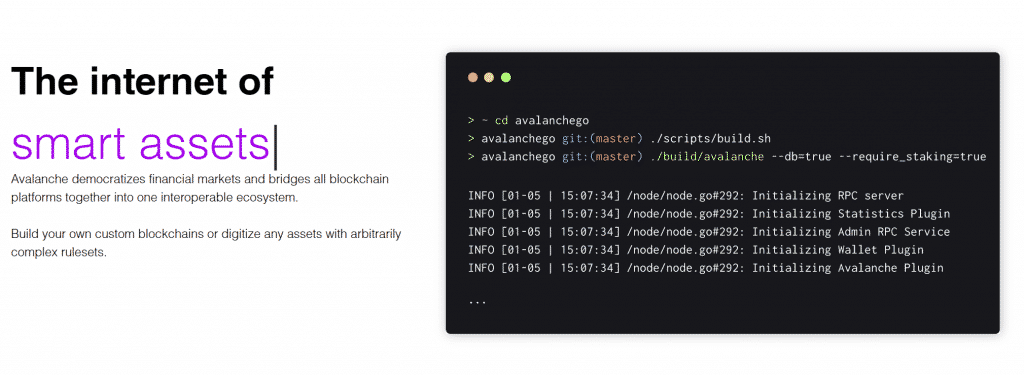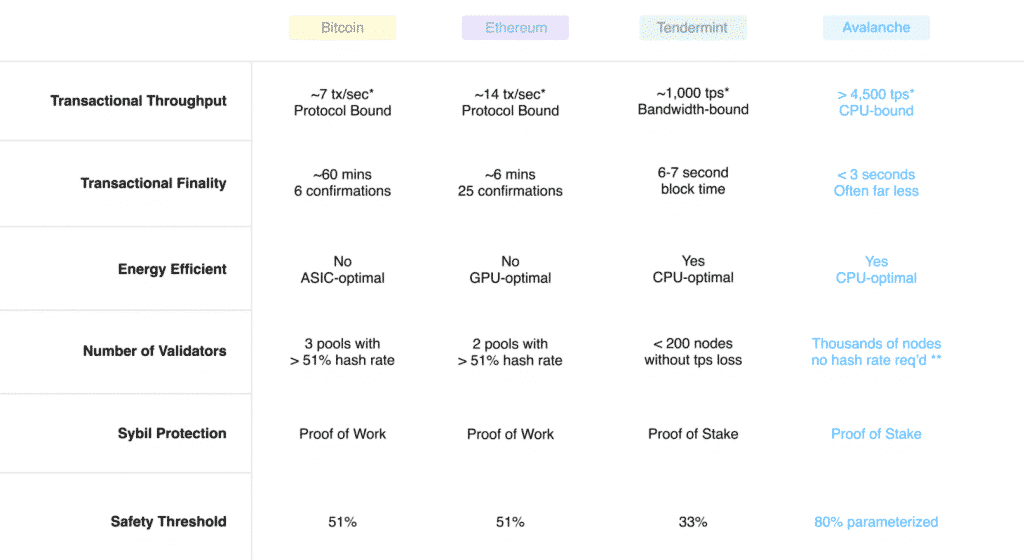Avalanche (AVAX)
Last Updated on 8 April 2024 by CryptoTips.eu
Avalanche (AVAX) is one of the newest projects that was launched in 2020. The mainnet went live in September 2020. Since its launch, the project has grown rather fast and is currently within the crypto top 30 based on market cap.
The project is created to serve several purposes in the decentralized web and the network processes 4,500 transactions per second. According to the Avalanche team, the project will help to solve the current problems in the blockchain industry.
This is made possible with the design of the project to enable easy use of decentralized web services such as smart contracts, dApps, smart assets and P2P payments. The network was created to serve as a platform for financial markets. This is because of the ability to easily create and launch smart assets on the network.
Such assets could be equities, bonds, debt, real estate and others. This tokenization is becoming a reality as has been predicted a long time ago. The network has been expanding its scope since the launch. New aspects of the network include Private Securities, ILOs, DEX’s, Synthetics, Stablecoins, Prediction Markets, and more.
Please enter and activate your license key for Cryptocurrency Widgets PRO plugin for unrestricted and full access of all premium features.
Avalanche (AVAX)
More information
What is Avalanche?
Imagine a place where it is possible to create new assets, launch customizable blockchains both public and private as well as build scalable smart contracts. That is Avalanche. Developers have different needs for their applications and sometimes require customized blockchains for some applications. Avalanche allows developers to build their own virtual machines and determine how the blockchains operate according to their needs. These blockchains come complete with scripting language, validator sets, legal compliance rules and more.

Avalanche also allows developers to launch new smart assets. These represent physical assets and can be traded on the platform based on the programmed rules. While there are a number of projects that support this function, Avalanche provides a new and better environment for such development.
As smart contracts are becoming a common part of human existence, developers can also create smart contracts and dApps that are scalable on the network. By leveraging the Avalanche protocol, it is possible to build smart contracts and dApps that confirm in seconds and is scalable to thousands and even millions validators. Developers can also transfer dapps written in Solidity to Avalanche which boosts the performance of the dApps.
The Avalanche team has also launched Avalanche-X, an accelerator program for developers building dApps for lending, derivatives and stablecoins to mention a few. With the program, programmers can submit a proposal for projects they are working on and get grants to support their work.
How does Avalanche work?
Avalanche is open-source, which means the codes can be seen and edited by anyone. The platform is used mainly for building and launching highly decentralized applications, financial apps and new interoperable blockchains. The network is interoperable, which allows developers to build new permissionless or permissioned interoperable blockchains seamlessly.
To do this, they can either import blockchains from somewhere else or create new ones from scratch on Avalanche. There are existing virtual machines on the network that developers can use to realize this. These include EVM, WASM, BTC Script and many others. Alternatively, they may choose to build their own virtual machines from scratch.
Developers are also able to import additional functionalities to add to their blockchains. This may be zero proof, for example, or any other features they wish to add. They then select a set of validators by defining who can be a validator or they can leave it open for anyone to apply to become a validator.
As earlier mentioned, developers can also use Avalanche to issue new assets. The idea is to solve the problem of assets with low or no liquidity at all as many existing assets are not traded efficiently.
Using Avalanche’s smart asset primitive, developers can digitize and launch assets with certain conditions that make them legally compliant. This can be done on new or existing markets where such assets are already traded. Launching such assets in compliance with the law is a new development peculiar to Avalanche.

Features of Avalanche
- Interoperability: Avalanche allows the building and development of interoperable blockchains.
- High performance: The Avalanche network settles thousands of transactions in seconds. This characteristic makes high volume P2P payments and asset transfers possible and seamless.
- Scalability: A major challenge faced by networks that support launching of new assets is scalability. This is the problem Ethereum currently faces. For Avalanche, it is possible to accommodate thousands and millions of network participants, because it is able to scale.
- Customizable: Blockchains launched on Avalanche are fully customizable, allowing developers to define their own validator sets if they wish. Such blockchains come with compliance and privacy by default.
What are the governance protocols of Avalanche?
Avalanche uses validators in sets known as subnets to reach consensus. There are two types of consensus engines:
- The first is the Avalanche Consensus Protocol which is a DAG-optimized protocol with high throughput, parallelizable and simple to prune.
- The second is Snowman which is a chain-optimized consensus protocol with high throughput, totally ordered and excellent for smart contracts.
While there are many subnets on Avalanche, all validators are required to be on the primary network only, while the others are optional. There are three blockchains on the primary network:
- Platform (P) Chain: This is the metadata chain that coordinates validators, tracks subnets and also allows the creation of new ones. It implements the Snowman consensus protocol.
- Exchange (X) Chain: This is the default asset chain on Avalanche. It enables the creation, exchange and cross-subnet transfer of assets. The X chain implements the Avalanche Consensus Protocol.
- Contract (C) Chain: The C chain is the default smart contract chain and enables the creation of Ethereum-based smart contracts on Avalanche. It implements the Snowman consensus protocol.
What is the main purpose of AVAX tokens on the Avalanche network?
AVAX is the native token created by Avalanche. The token is used for the following purposes on the Avalanche network:
- Securing the network: The AVAX token is used first of all to secure the network. Validators stake their tokens to achieve this aim. There is a circulating supply of 360 million AVAX and a maximum supply of 720 million.
- Fees: Those using the Avalanche network use AVAX to pay for operational costs on the network.
- Transfer of value: AVAX is used to transfer value between peers on the network to and from the Avalanche wallet. Validators are also rewarded using the token.
- Creating new subnets: Subnets are created on Avalanche all the time and AVAX is used in the process to make the creation possible.
Pros of Avalanche
Avalanche is a big addition to cryptocurrency projects working towards making Web3 a reality. The network makes it easy for developers to import or launch new interoperable blockchains with customizable features. This affords developers the flexibility they need to build unique blockchains both public and private. Such an advantage makes it easier for developers to work towards a truly decentralized web.
Another remarkable feature of Avalanche is Avalanche-X, a grant program that supports developers. There are many talented developers who don’t have access to funds. However with the help of this program, many will be able to complete their projects towards building excellent products on the network.
The scalability of Avalanche is another thing worth mentioning. This is a major advantage as it can accommodate thousands to million of participants at once and still maintain its high transaction throughput. This is a major improvement from Ethereum, the first network to offer the kind of services Avalanche offers to developers.
Interoperability is something that is required in the growing decentralized world. Avalanche offers this and makes it possible for developers to combine the characteristics of different blockchains to build unique products.
The capped supply of Avalanche also makes it a potential store of value. This is because supply will not increase even with increasing demand, which then makes it more valuable.

Cons of Avalanche
A problem with Avalanche is that its native token AVAX cannot be used as a currency. This is because currencies should be prone to inflation but its capped supply does not meet such a condition.
Also, Avalanche have to proof itself and it looks mainly good in theory. We have to see if it’s really better than Ethereum.
In summary
Avalanche is a versatile, decentralized network that offers a lot of value to developers. With it, it is possible to achieve the dream of a truly decentralized web. The network is transforming key aspects of the modern human society, namely payments, dApps, smart contracts and interoperable blockchains.
With these things in place, the Avalanche network can become a leader in the decentralized web, if everything works out as planned.
Navigation